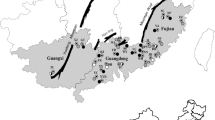Abstract
Randomly amplified polymorphic DNA (RAPD)variation in populations of the koala, Phascolarctoscinereus, was investigated, revealing significantdifferences in the level of diversity between southernand northern regions of eastern Australia. Of the20 polymorphic RAPD markers identified in koalas, 4-7were polymorphic in southern populations, while 12-17were polymorphic in northern populations. Analysis of molecular variance revealed a significantdifference in the estimated variance between koalas fromnorthern and those from southern regions (P < 0.001),where populations from the north were greater than twice as variable as their southerncousins. The total genetic diversity observed wasattributed to regional differences (30.91%), populationdifferences within a region (11.77%), and differencesamong individuals within a population (57.32%). Forthe within-region analyses, a large proportion of thegenetic diversity was attributable to individualdifferences within a population, 80.34% for the north and 91.23% for the south. These resultsdemonstrate that RAPD markers are useful for determiningpopulation structure among koalas.
Similar content being viewed by others
REFERENCES
Black, W. C., IV (1993). PCR with arbitrary primers: Approach with care. Insect Mol. Biol. 2:1.
Cocciolone, R. A., and Timms, P. (1992). DNA profiling of Queensland koalas reveals sufficient variability for individual identification and parentage determination. Wildlife Res. 19:279.
Excoffier, L., Smouse, P. E., and Quattro, J. M. (1992). Analysis of molecular variance inferred from metric distances among DNA haplotypes: Application to human mitochondrial DNA restriction data. Genet. Soc. Am. 131:479.
Fowler, E. V., Houlden, B. A., Sherwin, W. B., Hoeben, P., and Timms, P. (1998). Genetic variation in captive koalas (Phascolarctos cinereus): Parentage determination and individual identification. Biochem. Genet. 36:193.
Hadrys, H., Balick, M., and Schierwater, B. (1992). Applications of random amplified polymorphic DNA (RAPD) in molecular ecology. Mol. Ecol. 1:55.
Houlden, B.A., England, P. R., Taylor, A. C., Greville, W. D., and Sherwin, W. B. (1996). Low genetic variability of the koala Phascolarctos cinereus in south-eastern Australia following a severe population bottleneck. Mol. Ecol. 5:269.
Huff, D. R., Peakall, R., and Smouse, P. E. (1993). RAPD variation within and among natural populations of outcrossing buffalograss [Buchloë dactyloides (Nutt.) Engelm.]. Theor. Appl. Genet. 86: 927.
Jarne, P., and Lagoda, P. J. L. (1996). Microsatellites, from molecules to populations and back. Trends Ecol. Evol. 11:424.
Lewis, F. (1954). The rehabilitation of the koala in Victoria. Victorian Nat. 70:197.
Martin, R., and Handasyde, K. (1990). Translocations and the re-establishment of koala populations in Victoria (1944–988): The implications for New South Wales. In Lunney, D., Urquhart, C. A., and Reed, P. (eds.), Koala Summit: Managing Koalas in New South Wales, NSW National Parks and Wildlife Service, Hurstville, pp. 58–64.
Nusser, J. A., Goto, R. M., Ledig, D. B., Fleischer, R. C., and Miller, M. M. (1996). RAPD analysis reveals low genetic variability in the endangered light-footed clapper rail. Mol. Ecol. 5:463.
Pahl, L., Wylie, R., and Fisher, R. (1989). Koalas: The prospects for survival. Habitat Austral. 17:20.
Phillips, B. (1990). Koalas: The Little Australians We'd All Hate to Lose, Commonwealth of Australia, Canberra, pp. 31–49.
Podani, J. (1993). SYN-TAX Version 5.0. Computer Programs for Multivariate Data Analysis in Ecology and Systematics, Scientia, Budapest.
Reed, P. C., Lunney, D., and Walker, P. (1990). A 1986–1987 survey of the koala Phascolarctos cinereus (Goldfuss) in New South Wales and an ecological interpretation of its distribution. In Lee, A. K., Handasyde, K. A., and Hanson, G. D. (eds.), Biology of the Koala, Surrey Beatty and Sons, Sydney, pp. 55–74.
Rice, W. R. (1989). Analysing tables of statistical tests. Evolution 43:223.
Rico, C., Rico, I., and Hewitt, G. (1996). 470 million years of conservation of microsatellite loci among fish species. Proc. Roy. Soc. London B 263: 549.
Robinson, A. C. (1978). The koala in South Australia. In Bergin, T. J. (ed.), The Koala: Proceedings of the Taronga Symposium of Koala Biology, Management and Medicine, Sydney, 11 and 12 March 1976, Zoological Parks Board of NSW, Sydney, pp. 132–143.
Sharp, A. (1995). The Koala Book, Australian Koala Foundation, David Bateman Ltd., Auckland, pp.49–63.
Sinclair, E.A., Webb, N. J., Marchant, A. D., and Tidemann, C. R. (1996). Genetic variation in the little red flying fox Pteropus scapulatus (Chiroptera: Pteropodidae): Implications for management. Biol. Conserv. 76: 45.
Strahan, R., and Martin, R. (1982). The koala: Little fact, much emotion. In Groves, R. H., and Ride, W. D. L. (eds.), Species at Risk: Research in Australia, Australian Academy of Science, Canberra, pp. 147–155.
Taylor, A. C., Marshall Graves, J. M., Murray, N. D., O'Brien, S. J., Yuhki, N., and Sherwin, W. B. (1997). Conservation genetics of the koala (Phascolarctos cinereus): low mitochondrial DNA variation amongst Southern Australian populations. Genet. Res. 69: 25.
Taylor, A. C., Marshall Graves, J. A., Murray, N. D., and Sherwin, W. B. (1991). Conservation genetics of the koala (Phascolarctos cinereus). II. Limited variability in minisatellite DNA sequences. Biochem. Genet. 29:355.
Timms, P., Kato, J., Maugeri, M., and White, N. (1993). DNA fingerprinting analysis of a free-range koala population. Biochem. Genet. 31:361.
Warneke, R. M. (1978). The status of the koala in Victoria. In Bergin, T. J. (ed.), The Koala: Proceedings of the Taronga Symposium of Koala Biology, Management and Medicine, Sydney, 11 and 12 March 1976, Zoological Parks Board of NSW, Sydney, pp. 109–114.
Williams, J. G. K., Kubelik, A. R., Livak, K. J., Rafalski, J. A., and Tingey, S. V. (1990). DNA polymorphisms amplified by arbitrary primers are useful as genetic markers. Nucleic Acids Res. 18:6531.
Worthington-Wilmer, J. M., Melzer, A., Carrick, F., and Moritz, C. (1993). Low genetic diversity and inbreeding depression in Queensland koalas. Wildlife Res. 20:177.
Rights and permissions
About this article
Cite this article
Fowler, E.V., Hoeben, P. & Timms, P. Randomly Amplified Polymorphic DNA Variation in Populations of Eastern Australian Koalas, Phascolarctos cinereus. Biochem Genet 36, 381–393 (1998). https://doi.org/10.1023/A:1018701630713
Issue Date:
DOI: https://doi.org/10.1023/A:1018701630713




